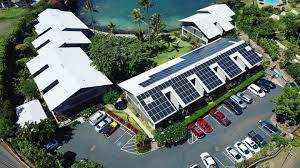What Is A Solar Panel?
Sun oriented energy is the innovation used to bridle the sun's energy and make it useable. Starting at 2011, the innovation delivered short of what one 10th of one percent of worldwide energy interest. Many know about purported photovoltaic cells, Maui solar companies or sunlight based chargers, found on things like space apparatus, housetops, and handheld adding machines. The cells are made of semiconductor materials like those found in microchips. At the point when daylight hits the cells, it thumps electrons free from their molecules. As the electrons move through the cell, they produce power.
On a lot bigger scope, sun oriented nuclear energy stations utilize different methods to think the sun's energy as a hotness source. The hotness is then used to bubble water to drive a steam turbine that produces power in much a similar design as coal and thermal energy stations, providing power for great many individuals.
It's bright occasions for sun based power. In the U.S., home establishments of sun powered chargers have completely bounced back from the Covid droop, with examiners foreseeing more than 19 gigawatts of all out limit introduced, contrasted with 13 gigawatts at the end of 2019. Over the course of the following 10 years, that number might fourfold, as per industry research information. What's more that is not in any event, thinking about the further effect of conceivable new guidelines and impetuses dispatched by the green-accommodating Biden organization.
Sunlight based's pandemic-evidence execution is to a great extent because of the Solar Investment Tax Credit, which settles 26% of sun oriented related costs for all private and business clients (simply down from 30% during 2006-2019). After 2023, the tax reduction will venture down to a long-lasting 10% for business installers and will vanish altogether for home purchasers. Consequently, deals of sun oriented will likely consume much more smoking before long, as purchasers competition to trade out while they actually can.
Charge endowments are by all account not the only justification for the sun based blast. The transformation productivity of boards has improved by as much as 0.5% every year throughout the previous 10 years, even as creation expenses (and subsequently costs) have strongly declined, on account of a few influxes of assembling development generally determined by industry-predominant Chinese board makers. For the end purchaser, this adds up to far lower front and center expenses per kilowatt of energy created.
This is generally extraordinary information, for the business as well as for any individual who recognizes the need to progress from petroleum derivatives to sustainable power for our planet's future. Yet, there's a gigantic admonition that not very many are discussing. Monetary motivating forces are quickly adjusting to urge clients to exchange their current boards for more up to date, less expensive, more effective models. In an industry where circularity arrangements, for example, reusing remain horrendously insufficient, the sheer volume of disposed of boards will before long represent a danger of existentially harming extents.

Comments
Post a Comment